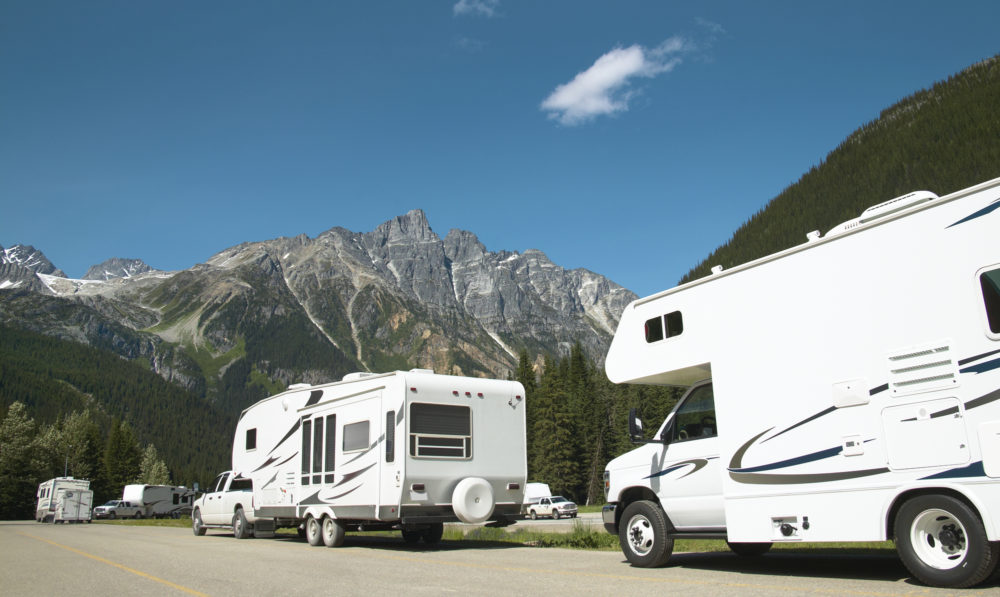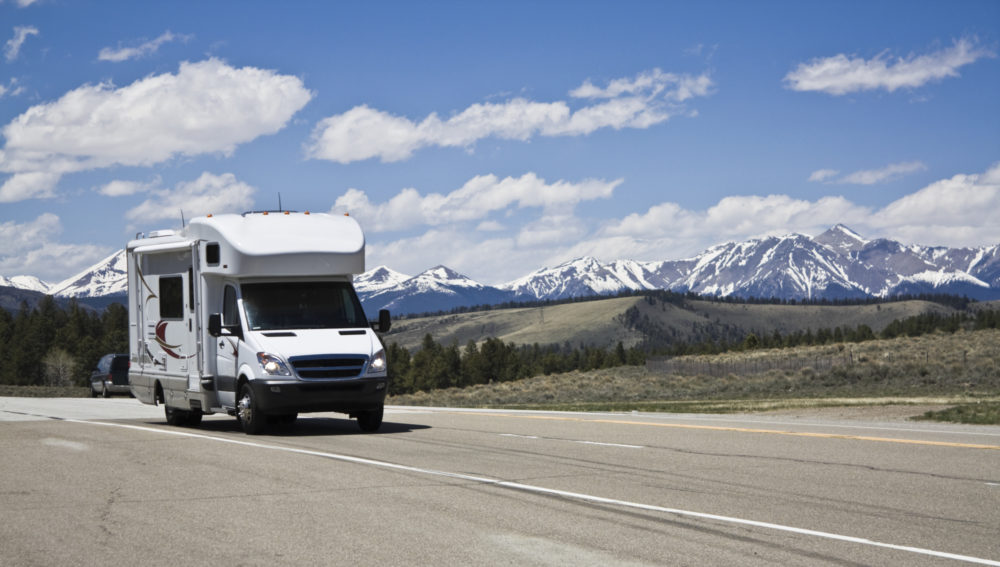What Is the RV 3-3-3 Rule?
The 3-3-3 Rule is a guideline that many veteran RVers use as they travel. Overtime, many discover by trial and error that this way of travel helps immensely to reduce traveling stress, as well as set-up at the RV park. In addition, it helps with body recovery in between travel days.

Contents
The 3-3-3 Rule simply means that one chooses:
- not to drive more than 300 miles in a day (with a small margin of 20 or so miles),
- To stop every 3 hours for a bathroom or stretch break and arriving at the campsite before 3 PM (to set up the site during daylight)
- To stay at an RV park for a minimum of three nights.
Some parks already have a minimum stay policy (standard is 2 nights minimum, especially on weekends), although the last rule is the only that is most likely to be adjustable, based on one’s traveling goals.
Why RVers Use The 3-3-3 Rule?
This rule is more of a guideline for people who are in no rush to get anywhere and prefer to travel safely and comfortably. This rule factors in any delays, stops or traffic jams for the most part, allowing for a comfortable travel pace and experience.
For those who keep this guideline, there are several benefits:
- Clear plan and expectations for driver and all travelers
- Easy travel days
- Easy planning
- Daylight for arrival and setup
- Less stress while driving (there is a margin in there for getting lost, taking a bathroom/lunch/sight-seeing break etc.)
- Early arrival allows for stress-free setup and dinner prep, even with time to spare for explorations (if desired)
- Easier on the vehicle’s wear-and-tear
- More economical fuel-cost-wise
What Should You Not Do In An RV?
Is it legal to walk around in an RV while driving?
This depends on each state one travels through, but most states do not allow free movement in an RV while it is moving, but rather sit with a seatbelt on for personal safety reasons.
Even if there is no law prohibiting free movement in an RV during travel, staying seated and secured with a seatbelt helps avoid serious injury or even fatality.
Can you use the bathroom in an RV while driving?
The same principle applies for the use of a bathroom. While the RV bathrooms are self-enclosed (especially during travel, the blacktank vent should be closed!), it’s a better idea to pull over at a gas station or another suitable spot to safely access the bathroom. Otherwise, there can be situations, just like using the toilet during a turbulent airplane flight.
Is it legal to sleep in an RV while driving?
The passenger is always welcome to take a nap in their seat, although it helps the driver to stay alert when the passenger is awake to keep company for directions etc.
When it comes to laying down in an RV during travel, the situation is the same as for walking or using the restroom during travel: Should the driver slam on the brakes, hit a bump or worse, the person would not only fall off the bed, but likely incur severe injuries.
What are other rules for riding an RV?
Other things to consider during RV travel are 1. securing of the pets and 2. securing of any lose items that could become flying projectiles.

Additional Tips For Surviving Long RV Trips
Before a long trip there are several things to consider to make things more enjoyable:
- Plug in the RV refrigerator into shore power at least 24 hrs before the trip, turn it on and pre-cool so that you can store your food and drinks you’d like to have access to on the road.
- Check the tire pressure (invest into a good Tire Pressure Monitoring System, or TPMS).
- Check the lug nuts and tighten, if needed.
- Make sure the hitch is at the proper torque, if applicable.
- Have a gallon container of water in the sink area, for washing hands and flushing the toilet on the road.
- Have a snack bag with drinks and food in the cockpit area.
- Set up your route on GPS, but have a written/printed copy of directions with a map as backup, in case you have no data where you travel.
- Things you don’t want to run out of: water, toilet paper, 24-48 hrs worth of food. Keep fast and easy food staples on hand. Pre-cut fruit, cheese cubes, marinate meat and veggies in a ziplock, and make your life easier when you arrive. No one likes to arrive and be hangry.
- Allow for bathroom and stretch breaks. While it’s fun to “get there”, it’s important to take it easy and take breaks. The worst thing is when everyone needs to “hold it” and you are stuck in traffic for 2 hours just before the destination.
FAQs:
What is the 10-year RV rule?
Many RV parks adopt a 10-year rule, meaning the RVs that stay there cannot be older than 10 years. This is often at nicer RV parks that try to avoid the “run-down RV trailer park” stigma or have an older unit leak or break down while there.
However, with the rising trend of refurbishing/remodeling of vintage units, as well as the fact that many top brands, such as Airstreams hold their value and remain in great condition past the 10-year mark, this rule is often one of the most resented ones by the visitors.
Sometimes, the RV park owners ask for images of an older unit prior to approval and reservations; sometimes, there are no exceptions.
Is it cheaper to travel by RV or stay in hotels?
It used to be more economical to stay in your own RV, especially when staying in one particular spot for an extended period of time. However, with the increase in fuel cost, the cost of the RV and tow vehicles, as well as rise in RV park fees, it has become more expensive to travel with an RV.
How much mileage is too much for an RV?
Most RVers average about 5,000 miles a year (if they are not full-timers). That being said, a reasonably expected lifespan of an RV is 20 years or about 200,000 miles. These numbers vary grealy on one’s amount of travel, regular maintenance and careful use, factory workmanship/brand and even price range.
How many miles can an RV go on a tank of gas?
This varies as greatly as the mileage for each car on the road; however, there are some average numbers to help someone get a better and more realistic idea.
While the mileage depends on the tow vehicle (performance and fuel tank capacity), the quality of fuel, the total weight of the RV being towed, gray and black water tanks being full or empty, as well as the route (hills, windy weather etc.), RVers often swap notes at campgrounds about what mileage they get with their setup.
For example: a newer RAM 2500 Cummins with a 35-ft fifth-wheel that is about 14,000 lbs total in weight can average about 12 mpg. That equates to about 250-300 miles per fuel tank on the tow vehicle.
When it comes to Class A, most units get about 9 miles a gallon, which can take them about 800 miles between refuel stops. A Class B outperforms in mileage with 19 mpg, on average, but with a smaller tank; this lasts about 450 miles between refuels.
What is the maximum RV length allowed on the road?
Although the restrictions vary by the state, the route and by the choice of setup (i.e. Class A with a “toad”-vehicle behind) or a tow vehicle with a trailer, the total length usually caps out at 65 ft max.
The tow length is also usually limited by 1. the tow capacity of the tow vehicle and 2. one’s ability to tow long RVs (especially off the interstate, considering the turning radius, bridges, access roads, RV park access, stops etc.). Many RVers try to stay under 45 ft, which is the length limit for most National and State Parks.
It is advisable to use an RV GPS to enter the total height and length of the RV to evaluate overall route options and accessibility with a large RV.




